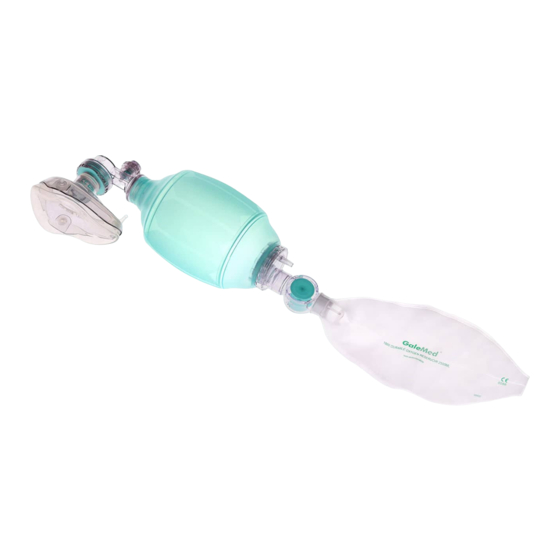GaleMed AR0097 Manual de instruções de utilização - Página 10
Procurar online ou descarregar pdf Manual de instruções de utilização para Equipamento médico GaleMed AR0097. GaleMed AR0097 12 páginas. Resuscitator silicone reservoir bag, 2l

Testing Oxygen Reservoir / Reservoir Valve
1. Attach the reservoir to the reservoir valve assembly. Attach the silicone bag.
2. Inflate the reservoir and block the reservoir port.
3. Compress the reservoir bag. Gas should escape through the safety outlet valve on the reservoir valve.
If not check that the reservoir valve is correctly assembled.
4. Connect the reservoir and reservoir valve assembly to a Resuscitator.
5. Cycle the Resuscitator through several ventilations. The safety inlet valve on the reservoir valve should
open during each refill to allow room air to enter the silicone bag. If not, check that the reservoir valve is
correctly assembled.
Note: If supplemental oxygen is not connected, the compressed bag will refill more slowly if the reservoir
is still attached.
5. General Safety Instruction
5.1 Operating Condition
5.1.1 Care during shipping and storage
‐ For compact storage, e.g., in an emergency case, the inlet end can be pushed halfway into the bag.
‐ Never store the resuscitator in a compressed or folded state.
‐ Never excessively squeeze the bag during storage. When the resuscitator is ready for use it should
not be kept in direct sunlight or in a heated environment.
‐ Storage temperature:
‐ For long‐term storage or transportation, the resuscitator should be kept in closed packing in a cool
place away from direct sunlight.
5.2 Possible side‐effect
Compressed pressure can increase in transpulmonary pressure, the patient's blood pressure can be reduced due
to a reduction in pre‐load.
5.3 Possible Risks
5.3.1 Residual Risk
0. Hyperventilation may be occurred by three factors: there is no monitoring of ventilatory parameters on manual
resuscitators, there is no direct evaluation of ventilation quality, and there is limited understanding of the
patient's needs from rescuers with less experience.
1. High pressure can cause barotrauma (injury from high pressure), especially for neonates and prefer to use a BVM
with an integrated manometer.
2. High inspiratory lung volumes (or pressures) can cause injury through alveolar overdistension, causing alveolar
rupture, and cell death.
-40°C to 60°C (-104°F to 140°F)
